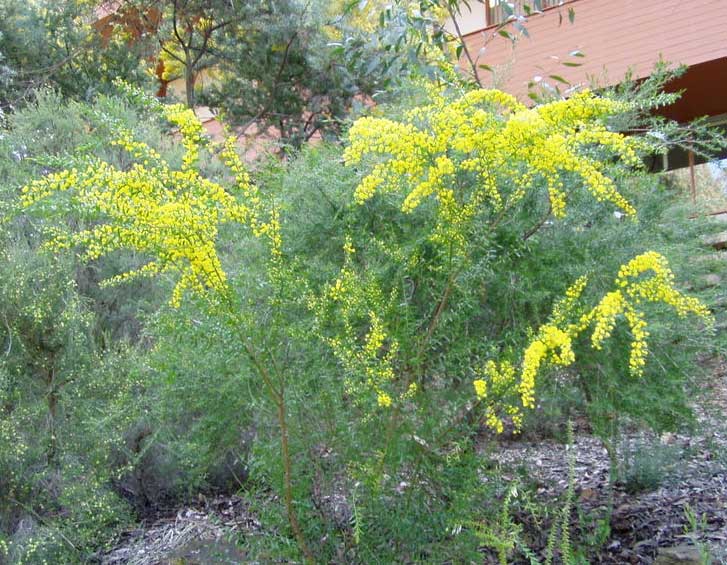
Acacia acinacea (*)
Classification System: APG IV
Superregnum: Eukaryota
Regnum: Plantae
Cladus: Angiosperms
Cladus: Eudicots
Cladus: Core eudicots
Cladus: Rosids
Cladus: Eurosids I
Ordo: Fabales
Familia: Fabaceae
Subfamilia: Caesalpinioideae
Tribus: Acacieae
Genus: Acacia
Species: Acacia acinacea
Name
Acacia acinacea Lindl. 1838
Synonyms
Acacia acinacea var. brevipedunculata Regel
Acacia cyclophylla Schltdl.
Acacia latrobei Meisn.
Acacia obliqua A.Cunn. ex Benth.
Acacia ovata Anon.
Acacia rotundifolia Hook.
Racosperma acinaceum (Lindl.) Pedley
Distribution
Native distribution areas:
Acacia acinacea
Continental: Australasia
Regional: Australia
New South Wales, South Australia, Victoria
Introduced into:
India
References: Brummitt, R.K. 2001. TDWG – World Geographical Scheme for Recording Plant Distributions, 2nd Edition
References
Primary references
Lindley, J. in Mitchell, T.L. 1838. Three Expeditions into the interior of Eastern Australia: with descriptions of the recently explored region of Australia Felix, and of the present colony of New South Wales. 2. Project Gutenberg, Archive.org Reference page. : 2:265.
Acacia acinacea, commonly known as gold dust wattle,[3] is a flowering shrub. It is native to south eastern Australia and lives for 15 years on average. This wattle species is tolerant of drought and frost. It is also known as wreath wattle or round-leaf wattle.[4]
Description
This shrub can have a bushy or straggly habit and typically grows to a height of around 2.5 m (8 ft 2 in). It has glabrous or hairy branchlets that are angled at the extremities. Like most species of Acacia it has phyllodes rather than true leaves. The glabrous or hairy evergreen phyllodes often have an asymmetric oblong-elliptic, broadly obovate or circular shape, and have a length of 0.4 to 1.5 cm (0.16 to 0.59 in) and a width of 2 to 8 mm (0.079 to 0.315 in) with an obscure or absent midrib. It blooms, usually prolifically, between July and November producing spherical flower-heads with a diameter of 4 to 4.5 mm (0.16 to 0.18 in) containing 8 to 20 golden coloured flowers. After flowering glabrous, crustaceous seed pods form that are circinnate to spirally coiled or irregularly twisted. The pods have a width of 3 to 4.5 mm (0.12 to 0.18 in) with longitudinally arranged seeds inside. The shiny dark brown seeds have an oblong shape and a length of 4 to 5 mm (0.16 to 0.20 in) with a clavate aril that can be half as long as the seed.[5]
Taxonomy
The species was first formally described by the botanist John Lindley in 1838 as part of Thomas Mitchell's work Three Expeditions into the interior of Eastern Australia. It has many synonyms including Acacia acinacea var. acinacea and Racosperma acinaceum.[6] The specific epithet, acinacea, derives from the Latin for a short Persian sword (acinaces) and references the shape of the phyllodes.[7]
Distribution
It is endemic and common throughout most of Victoria, south eastern South Australia, south eastern New South Wales and the Australian Capital Territory.[5] It is often found in hilly country and grows well in sand, sandy loam and gravelly soils as a part of Eucalyptus woodlands, woodland heath and open mallee scrubland communities.[4] It is a hardy, free-flowering species with very specific soil requirements. The requirements are that the soil is well-drained and non-saline, although it can tolerate many different types.
References
"Acacia acinacea". Australian Plant Name Index (APNI), IBIS database. Centre for Plant Biodiversity Research, Australian Government, Canberra. Retrieved 4 December 2012.
Lindley, J. in Mitchell, T.L. (1838) Three Expeditions into the interior of Eastern Australia 2: 265.
Warren and Gloria Sheather. "Acacia acinacea, Gold Dust Wattle". Australian Plants Society NSW. Retrieved October 8, 2019.
"Acacia acinacea Lindl". Wattle - Acacias of Australia. Lucid Central. Retrieved 8 October 2019.
"Acacia acinacea Lindl. Gold-dust Wattle". VicFlora. Royal Botanic Gardens, Victoria. Retrieved 8 October 2019.
"Acacia acinacea Lindl". Atlas of Living Australia. Global Biodiversity Information Facility. Retrieved 8 October 2019.
eFloraSA: Acacia acinacea. Electronic Flora of South Australia, Government of South Australia. Retrieved 19 July 2019.
Links
Govaerts, R. et al. 2020. Acacia acinacea in Kew Science Plants of the World online. The Board of Trustees of the Royal Botanic Gardens, Kew. Published on the internet. Accessed: 2020 Jul 23. Reference page.
International Plant Names Index. 2019. Acacia acinacea. Published online. Accessed: Jul 23 2019.
Tropicos.org 2019. Acacia acinacea. Missouri Botanical Garden. Published on the internet. Accessed: 2019 Jul 23.
Hassler, M. Jul. Acacia acinacea. World Plants: Synonymic Checklists of the Vascular Plants of the World In: Roskovh, Y., Abucay, L., Orrell, T., Nicolson, D., Bailly, N., Kirk, P., Bourgoin, T., DeWalt, R.E., Decock, W., De Wever, A., Nieukerken, E. van, Zarucchi, J. & Penev, L., eds. Jul. Species 2000 & ITIS Catalogue of Life. Published on the internet. Accessed: Jul 23 {{{3}}}. Reference page.
USDA, ARS, Germplasm Resources Information Network. Acacia acinacea in the Germplasm Resources Information Network (GRIN), U.S. Department of Agriculture Agricultural Research Service. Accessed: 09-Oct-10.
Vernacular names
English: gold dust wattle
Retrieved from "http://en.wikipedia.org/"
All text is available under the terms of the GNU Free Documentation License

